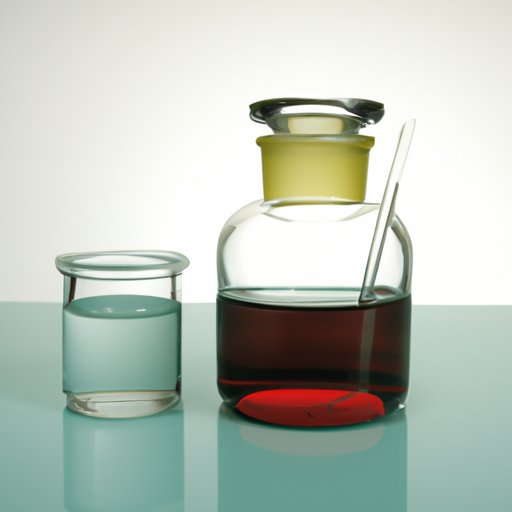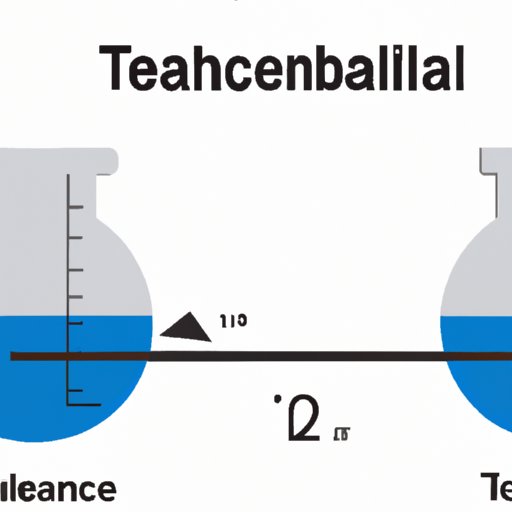Introduction
When we place substances in a sealed flask, we expect them to reach a state of equilibrium, but understanding what type of equilibrium exists can be quite challenging. The type of equilibrium determines the behavior of the substances inside the flask and their reaction to external forces. The goal of this article is to explore the different types of equilibrium that can exist in a sealed flask, the conditions required to achieve each, and the factors that affect them.
This article is intended for anyone interested in understanding the science behind the behavior of substances in a sealed flask. Whether you are a student studying chemistry or physics or a researcher studying thermodynamics, this article provides a comprehensive guide to help you understand the topic.
Thermodynamic Equilibrium in a Sealed Flask
Thermodynamic equilibrium occurs when a system is in a state of balance and has no net change in any of its macroscopic properties. In a sealed flask, thermodynamic equilibrium occurs when the temperature, pressure, and composition of the system inside the flask are constant. At thermodynamic equilibrium, the system is said to be in a stable state that can be described by its equations of state.
Achieving thermodynamic equilibrium is important because it ensures that the system is in a state of balance and that no further change in its macroscopic properties will occur. Achieving thermodynamic equilibrium in a sealed flask is crucial because it helps researchers understand the behavior of the substances and how they react to changes in the environment.
Differentiating Between Mechanical and Chemical Equilibrium
Mechanical and chemical equilibrium are the two types of equilibrium that can exist in a sealed flask. Mechanical equilibrium occurs when there is no net movement of matter or energy within the system, which means that the pressure within the system is uniform. Chemical equilibrium occurs when the chemical reaction has reached its final state and no further changes occur in the concentration of reactants or products.
The primary difference between mechanical and chemical equilibrium is that mechanical equilibrium describes the physical state of the system, whereas chemical equilibrium describes the chemical state of the system. Therefore, it is important to differentiate between the two types of equilibrium to understand the behavior of a sealed flask.
Conditions for Achieving a State of Thermodynamic Equilibrium in a Sealed Flask
Three conditions are required for achieving thermodynamic equilibrium in a sealed flask. The first is a constant temperature, which means that the temperature within the system must remain constant to achieve thermodynamic equilibrium. The second is a constant pressure, which means that the pressure within the system must remain uniform. Finally, no external forces can be present that might disturb the system.
For example, imagine filling a flask with water and then sealing the opening. The temperature must remain constant, and the pressure within the flask must remain constant. Furthermore, no external forces can be present that could disturb the system. Therefore, the flask should be placed in a stationary position and left to reach equilibrium.
Examples of How Equilibrium Can be Reached in a Sealed Flask
Several examples demonstrate how equilibrium can be reached in a sealed flask.
The first example is carbon dioxide in a sealed container. When we add an acidic solution to baking soda, it releases gas, which fills the container. However, the rate at which the gas is produced slows and eventually stops, indicating that the system is in a state of equilibrium. The chemical reaction between the baking soda and acid produces carbon dioxide gas, which fills the container. At equilibrium, the rate of production of carbon dioxide gas is equal to the rate of consumption of carbon dioxide gas.
The second example is the phase change of water in a sealed container. When we fill a flask with liquid water and seal it, the system will undergo a phase change when it reaches a certain temperature. The water will eventually reach a state of equilibrium where the amount of water in the liquid phase and the amount of water in the gas phase are equal.
Factors That Affect the Type of Equilibrium That Exists in a Sealed Flask
Several factors affect the type of equilibrium that exists in a sealed flask, including temperature, pressure, concentration, and volume. The temperature within the flask must be constant to achieve thermodynamic equilibrium, and changes in temperature can affect the type of equilibrium that exists. Pressure must also be constant to ensure that the system is in mechanical equilibrium.
The concentration of reactants in a system also affects the type of equilibrium that exists. Increasing the concentration of one reactant can shift the equilibrium towards the products, whereas decreasing the concentration of a reactant can shift the equilibrium towards the reactants.
Finally, the volume of the container also affects the type of equilibrium. Changing the volume of the container can affect the pressure and temperature within the system, which means that it can also affect the type of equilibrium that exists.
Applications of Understanding Equilibrium in a Sealed Flask
Understanding the different types of equilibrium in a sealed flask has applications in fields such as chemistry, physics, and engineering. The behavior of chemical reactions in a sealed flask depends on the type of equilibrium that exists, and this knowledge can be used to determine the rate of reactions, their direction, and the products formed.
This understanding is also essential in developing strategies to control the environment around the substances in the flask, which can be used to improve the efficiency of industrial processes. Equilibrium in sealed flasks is also important in the design of equipment for processes such as distillation, which is widely used in chemical engineering.

Experimental Methods to Determine the Type of Equilibrium in a Sealed Flask
Several experimental methods can be used to determine the type of equilibrium that exists in a sealed flask. These methods include measurements of temperature, pressure, and concentration within the system.
For example, researchers can use the van’t Hoff equation to determine the equilibrium constant of chemical reactions. The van’t Hoff equation relates equilibrium constant to temperature, and the values obtained can be used to assess the rate of a reaction and predict the products formed.
Conclusion
Thermodynamic, mechanical, and chemical equilibrium are the different types of equilibrium that can exist in a sealed flask. Each equilibrium type is defined by the physical and chemical properties of the substances within the flask. Understanding the behavior of substances in a sealed flask is crucial in various fields, including chemistry, physics, and engineering. Experimental methods such as temperature, pressure, and concentration measurements can be employed to determine the type of equilibrium. Finally, achieving thermodynamic equilibrium in a sealed flask ensures that the system is in a state of balance and that no further changes will occur.
Therefore, it is essential to understand the behavior of substances in a sealed flask and the different types of equilibrium that exist to enable better control over chemical reactions and improve the efficiency of industrial processes.
